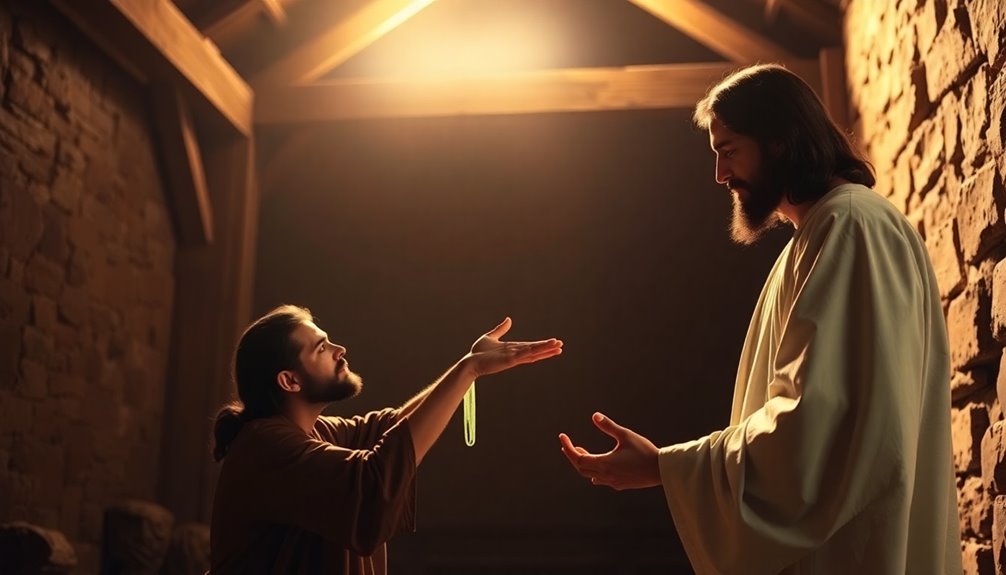In John 20:24-29, you see how Jesus compassionately addresses Thomas' doubts after the resurrection. Thomas, having missed the first appearance, demands to touch Jesus' wounds for belief. A week later, Jesus appears to him, inviting him to see and touch. This moment transforms Thomas' skepticism into profound faith as he confesses, "My Lord and my God!" Jesus then emphasizes the blessing of believing without seeing, highlighting the value of faith in the unseen. There's more to explore!
In a moment that would forever change his faith, Thomas, often called Didymus, found himself grappling with doubt after missing Jesus' first post-resurrection appearance to the disciples. The other disciples excitedly shared their experience of seeing the risen Christ, but all Thomas could feel was skepticism. They claimed that Jesus had risen from the dead, but how could he believe without tangible proof? His stubborn insistence on needing to see and touch Jesus' wounds became a defining moment in his journey.
Thomas famously declared, "Unless I see in His hands the mark of the nails, and place my finger into the mark of the nails, and place my hand into His side, I'll never believe." This statement highlights his struggle with doubt, a feeling many can relate to. In today's world, faith often demands a leap into the unknown, but Thomas sought a solid foundation. His desire for physical evidence echoed a longing for reassurance, something we all desire when faced with uncertainty.
A week later, Jesus appeared again, and this time, Thomas was present. The atmosphere must have been electric with anticipation and fear. Jesus, knowing Thomas' doubts, approached him with compassion. He invited Thomas to touch His wounds, saying, "Put your finger here, and see my hands; and put out your hand, and place it in my side. Don't disbelieve, but believe." This invitation wasn't just a challenge; it was an act of understanding. Jesus recognized Thomas' need for evidence, and instead of rebuking him, He offered the reassurance Thomas sought.
In that profound moment, Thomas's doubt melted away. Upon touching the wounds of Jesus, he made one of the most significant confessions of faith in the New Testament, exclaiming, "My Lord and my God!" This declaration not only affirmed his faith but also recognized Jesus' divinity.
Jesus then addressed Thomas, saying, "Have you believed because you have seen me? Blessed are those who haven't seen and yet have believed." This statement emphasizes the importance of faith, encouraging all believers to trust without requiring physical proof.
In a world where doubt often clouds our beliefs, Thomas' journey from skepticism to confession serves as a powerful reminder of the transformative nature of faith in the resurrection of Jesus.
Frequently Asked Questions
What Did Jesus Say to Thomas in John 20 24 28?
In John 20:24-28, Jesus directly addresses Thomas's doubts. He invites you to touch His wounds, saying, "Put your finger here; see my hands."
He encourages you to reach out and see for yourself. Thomas responds with a powerful declaration, recognizing Jesus as "My Lord and my God!"
Jesus then emphasizes that those who believe without seeing are blessed, highlighting the beauty of faith beyond physical proof.
Where in the Bible Did Jesus Appear to Thomas?
You can find Jesus' appearance to Thomas in the Gospel of John, specifically in chapter 20, verses 24-29.
In this passage, Thomas, who was absent during Jesus' earlier appearance to the disciples, expresses doubt about the resurrection.
When Jesus later visits and invites Thomas to touch His wounds, Thomas's faith is transformed, leading him to declare Jesus as his Lord and God.
This moment highlights the importance of belief, even without physical proof.
How Long After the Resurrection Did Jesus Appear to Thomas?
Jesus appeared to Thomas eight days after the resurrection. This timeframe suggests that Thomas missed the initial encounter with the rest of the disciples, leading to his skepticism.
You might find it interesting that this delay emphasizes the significance of personal experiences in faith. It shows that even those who doubt can have transformative moments when they seek evidence and affirmation, ultimately deepening their belief and connection to the divine.
What Reason Did Jesus Give to His Disciples in John 13, 19, and 14, 29 for Revealing Future Events?
When it comes to preparing for the future, Jesus had a clear purpose.
He revealed future events to His disciples to help them believe in His divine identity and to provide peace and confidence. By telling them what was to come, He aimed to strengthen their faith and reassure them that He's in control.
In essence, His insights were meant to help them navigate the stormy seas of uncertainty ahead.
Conclusion
In the moment Jesus reveals himself to Thomas, doubt transforms into unwavering faith. Just like the saying goes, "Seeing is believing." You can feel the weight of Thomas's struggle melt away as he encounters the risen Christ. This powerful moment reminds us that even in our darkest doubts, hope awaits just around the corner. When you open your heart to the divine, you'll discover that faith can flourish, turning uncertainty into a profound connection with the divine.










